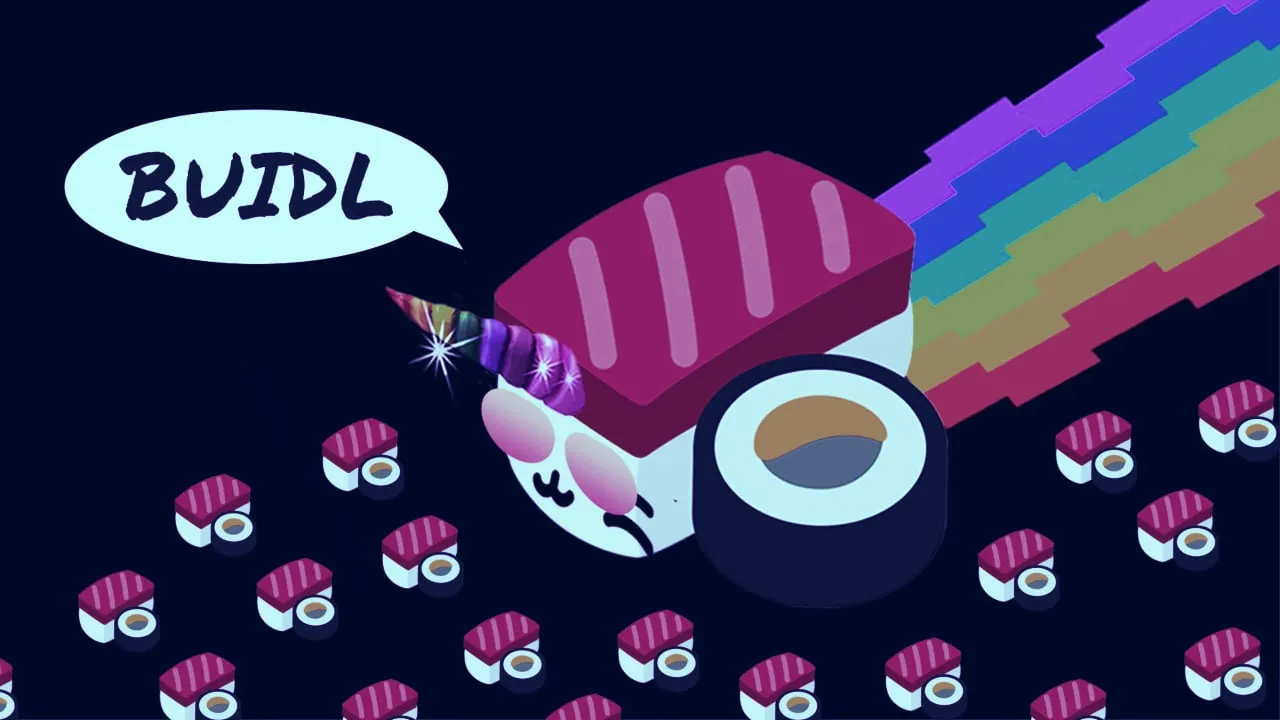In brief
- As DeFi has exploded this summer, so has its weird spin off: meme coins.
- Although meme coins have been around since Dogecoin, DeFi meme coins are different—and billions of dollars are being invested into them.
- And Ethereum developers who spoke to Decrypt said these coins are much more than just harmless fun.
Investors plugged $8 billion dollars into decentralized finance (DeFi) in the past three months alone, motivating the more creative members of its community to find new ways to create billions more in value.
The result is the latest craze that has taken hold of the cryptocurrency industry: DeFi versions of meme coins, crypto tokens whose worth depends on how funny the Internet finds the joke they represent.
DeFi “Degens,” as the users of such tokens self-identify, have cooked up an endless platter of meme coins: $TACO, $TENDIES, $YAM, $SUSHI, are among recent coins that riff on DeFi’s theme of “money lego,” with more coming out each day to serve investors’ endless appetite. They are immensely popular: $SUSHI, which powers a new take on decentralized exchange Uniswap, traded $127 million yesterday. And it only launched last week.
But there’s a much darker side to meme tokens. Some think that they’re nothing but quick money grabs, reminiscent of the sham ICOs that took advantage of 2017’s bull market. More still think that these tokens are just another way to lure investors into an unsustainable DeFi economy.
“Meme tokens of today have actual value, but it’s propelled by this exuberation to keep farming, keep adding liquidity, keep earning interest. It’s quite insane,” Jordan Lyall, DeFi product lead at ConsenSys, told Decrypt. (Lyall got mixed up in this when he made a joke on Twitter and someone turned it into a meme coin). “Some are interesting models of distributing tokens, some are outright scams, the majority though are in this weird middle ground,” he said.
What are DeFi meme coins?
Meme coins have been around since the start of cryptocurrencies. The first major one was Dogecoin, which exploded with popularity—despite starting out as a joke. Launched in 2013 to poke fun at Bitcoin, it’s based on the Japanese Shiba Inu meme. To this day it’s the biggest meme coin—and Elon Musk’s favorite crypto, by the way—with a market cap of over $354 million.
But DeFi meme coins are a little different. They are extensions of this summer’s DeFi craze: tools built on Ethereum that aim to rebuild financial services like borrowing and lending and make them available to anyone. The space took off: Investors have locked $9 billion of crypto into its smart contracts, per metrics site DeFi Pulse.
Some DeFi meme coins add value to the space, or have their own unique takes on its core ideas of non-custodial finance. $SUSHI creates new incentives for people to provide liquidity to the decentralized exchange economy—a kind of Uniswap tailor made for the most “degen” of DeFi Degens. In the past 24 hours, $385 million of the token has been traded, CoinMarketCap data shows. The token’s market cap is more than $241 million. It didn’t exist a little over a week ago.
Another, $BASED, wants to ward the industry away from price speculation to a focus on monetary supply. Every day, the protocol resets the price, burning or minting users’ tokens—its creators describe it as a “post-modern economic game.” If memes help spread DeFi’s gospel—non-custodial finance for all—then so be it, say the true believers.
Meme coin $TACO works by allowing its users to “crunch” tokens by burning 6% of the Uniswap pool every day and earning a reward for their work. It claims to be a “fairer” and more fun version of TENDIES—the popular meme coin and deflationary token whose name has its origins in a dark Internet incest joke.
Generally these coins are variations on yield farming—where users earn extra tokens by staking cryptocurrencies in DeFi protocols. The idea was spearheaded by Compound, one of the largest DeFi lending protocols, which in late-June started rewarding loyal customers with $COMP, a so-called governance token that lets holders vote on network proposals. They’re also held as speculative value, in practice are incentives to invest in DeFi lending protocols.
Such DeFi yield farming coins include $YAM, which drew in $400 million in one day from investors.
Short shelf lives
But once the novelty wears off, these meme tokens reveal their unforgiving side. Set Labs product marketing manager and Co-Founder of EthHub, Anthony Sassano, said it’s just like the 2017 ICO scene: “Lots of people will get burnt by participating in things that they don't understand,” he told Decrypt.
Vitalik Buterin, the co-founder of Ethereum, even compared the DeFi yield farming craze to the way central banks are continuing to print money—and said he himself would be staying away from it.
But that’s not the only worry, according to ETH developers. So-called flash farms—yield farms that only really last a week or so—are risky. Shrimp, Porkchop and Spaghetti all drew attention, with their emoji or meme to accompany their logo, and investors pouring in millions. Some have seemingly been forgotten about as the hottest new token hit the block. KIMCHI, a fork (essentially a copy) of $SUSHI, locked up nearly half a billion in value just hours after starting trading on Tuesday.
ConsenSys developer Jack Clancy said you’d “have to be insane” to buy such tokens. “Unlike some of these yield farming experiments there isn’t really anything useful to learn here,” he said. “There’s no governance or anything so I don’t really understand the point. Maybe to learn if deflationary currencies work or whether people are willing to assign value to pure nonsense?”
Sassano added in a blog post that these meme coins “tend to use unaudited and untested code” and are “obviously not sustainable.” The hugely popular $YAM, for example, had problems. After $600 million was locked up in the project, those behind it admitted there was a fault and would have to be shut down—all within 48 hours. It reworked a new version of the protocol for users but the token has now basically been abandoned.
The team behind $TACO told Decrypt that the ETH developers had a point about the longevity of such projects and the risks involved: “The creators of these projects haven't promised the next Bitcoin—or even the next Dogecoin,” they said. “They've promised a social experiment / on-chain game whose shelf life may prove to be limited, or, like Dogecoin, may prove to have surprising longevity.”
One thing is certain though: just like the ICO boom of 2017, some serious money is being made right now—but serious money will undoubtedly be lost, too.
Disclaimer
The views and opinions expressed by the author are for informational purposes only and do not constitute financial, investment, or other advice.

